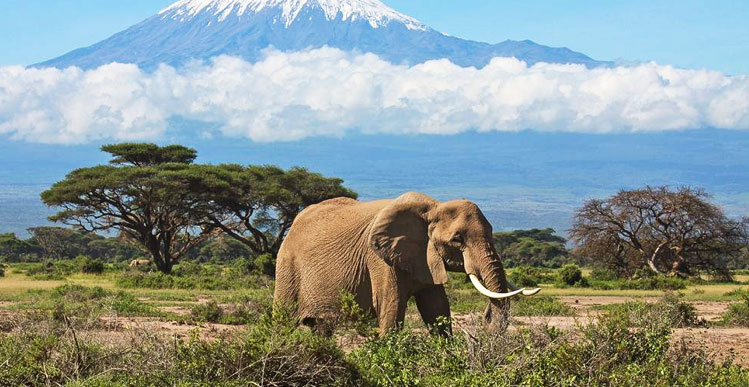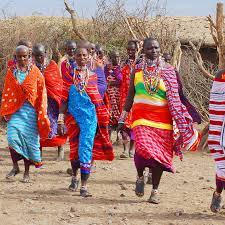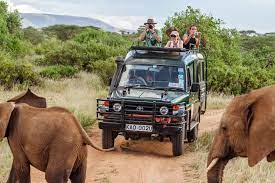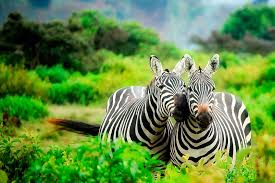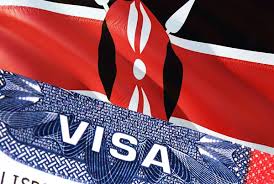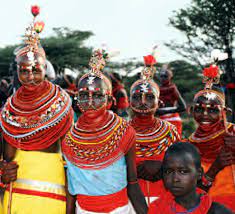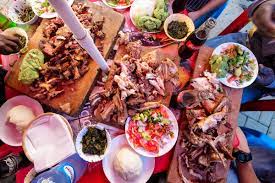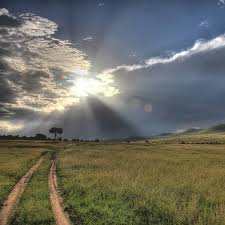Overview
Size: 1,668 sq km (641 sq miles) Established: 1921 established as a forest reserve, 1973 as a national park and declared a UNESCO world heritage site in 1987. Distance from Arusha: 128 km (80 miles)
Kilimanjaro National Park is home to the highest mountain in Africa and the highest free standing mountain in the world. Mount Kilimanjaro is made up of three volcanoes, Shira in the west (4,269 m) Mawenzi in the east (5,280 m) and the youngest volcano Kibo (5,895m). Shira and Mawenzi are extinct and the last major eruption of Kibo was between 150,000 and 200,000 years ago. Today Kibo is dormant but could awaken any day. The vegetation on the mountain is also very varied and some 2,500 species of plants are found here including the endemic and beautiful red and yellow impatiens kilimanjari as well as the colorful violet viola. The lower regions of the park are dominated by lush green montane forests with almost 140 species of trees. A bit higher up, distinctive giant lobelias grace the moorland zone. Above 4,000 m one finds the moonlike desert, where not much grows and the land is full of rocks and dust. Closer to the summit, hikers will be rewarded with beautiful sights of glaciers and a deep crater.
Out of the approximately 140 mammal species that live in the park, 87 of them are forest species. Animals that roam here include elephants, leopards, buffaloes, varies antelopes including the rare and endangered abbot duiker as well as primates such as the colobus and the mitis monkey. In addition hereto, 24 species of bats and 179 highland bird species have also been spotted in the Kilimanjaro National Park. The majority of visitors to the park are hikers. As is to be expected, all have the same goal in mind – to make it to Africa’s highest peak. There are seven official routes to choose from with Marangu being one of the easiest routes for unexperienced hikers and those in search for a bit more comfort (overnights take place in huts). The Rongai route is the quietest route and the best choice if you are climbing in the rainy season as this part of the mountain gets the least precipitation. Camping routes include Lemosho, Shira and Machame and all are a bit more challenging but also much more scenic. The most demanding but also the least used route is Umbwe. Apart from Marangu and Rongai all other routes descend on the Mweka route.
Best Time to Visit
Clearest and warmest conditions from December to February, but also dry (and colder) from July to September.
(a) Any time! I’ve got my gear. Get me there now!
(b) When it rains
(c) During Summer
(d) It all depends on me
Think about this for a moment. Don’t rush. Maybe (a)? Possibly (c)? Confused? Don’t be. Let’s explain.
Any Time (a)
While we love this type of excitement, climbers should not venture up Kilimanjaro whenever they please. There are specific months when climbing is not fun and unsafe. This leads us to…
When it Rains (b)
While this answer is incorrect, it does help explain why certain months are not conducive to Kili climbing. The times between April and May and mid-November through mid-December are when Tanzania receives a significant amount of rainfall. There is not enough for a person to boat up Kilimanjaro, but there’s still enough to render Kilimanjaro relatively miserable and unsafe to climb.
Summer (c)
Terms like “summer” and “winter” are kind of relative when it comes to Mt. Kilimanjaro and Tanzania. This is because there’s really only a 10-15-degree difference between the hottest months and the coolest.
The truth is that whenever you climb Kilimanjaro, the weather will likely be warm at your starting point in the foothills and cold at the summit. Yes, the exact temperatures may vary among different months, but this variance is only slight in degree. For example, the foothills may be a bit warmer in one month compared to the next, and the summit may be a bit colder in one month compared to the next. But, you’re still working with temperatures that are warm at the base of Kilimanjaro and cold at its top.
Getting There
One hour drive from Moshi town or Kilimanjaro International Airport
Activities
- Trekking Mt Kilimanjaro
- Wildlife Watching
Mt Kilimanjaro can be climbed at any time of year, though weather patterns are notoriously erratic and difficult to predict. Overall the best time for climbing the mountain is in the dry season, from late June to October, and from late December to February or early March, just after the short rains and before the long rains. During November and March/April, it’s more likely that paths through the forest will be slippery, and that routes up to the summit, especially the Western Breach, will be covered by snow. That said, you can also have a streak of beautiful sunny days during these times. Don’t be fooled by the number of people who climb Kilimanjaro – this is a serious undertaking. While many thousands of trekkers reach Uhuru Peak without major difficulty, many more don’t make it because they suffer altitude sickness or simply aren’t in good enough shape. And every year some trekkers and porters die on the mountain. Come prepared with appropriate footwear and clothing, and, most importantly, allow yourself enough time. If you’re interested in reaching the top, seriously consider adding at least one extra day on to the ‘standard’ climb itineraries. Although the extra US$150 to US$250 may seem a lot when you’re planning your trip, it will seem insignificant later on if you’ve gone to the expense and effort of starting a trek and then can’t reach the top. Don’t feel bad about insisting on an extra day with the trekking companies: standard medical advice is to increase sleeping altitude by only 300m per day once you’re above 3000m; this is about a third of the daily altitude gains above 3000m on the standard Kili-climb routes offered by most operators.
It’s also worth remembering that it’s not essential to reach Uhuru Peak, and you haven’t ‘failed’ if you don’t. If time (or money) is limited, choose other treks, and you can then experience several different mountain areas for the price of a single Kili climb. Consider trekking up to an area such as the Saddle, the top of the Barranco Wall or the Shira Plateau to appreciate the splendour and magnificence of the mountain without the slog of summiting.
Warning: Park-Fee Scams & Disreputable Guides
Paying park fees For anyone paying directly at the gate, all entry, hut, camping and other park fees must be paid with Visa or MasterCard and your PIN. One scam involves the relevant officer billing you for less than you owe (eg Tsh100 instead of US$100). As you exit the park after your trek, they point this out to you and ask you to pay the difference in cash. The cash, of course, goes into the pocket of whoever is collecting it. Carefully check the amount (and currency) before entering your PIN and keep all receipts at least until after you’ve left the park. Disreputable guides While most guides are dedicated, professional, properly trained and genuinely concerned to make your trip safe and successful, there are exceptions. Although it doesn’t happen often, some guides leave the last hut deliberately late on the summit day to avoid going all the way to the top. Going with a reputable company – preferably one that hires full-time guides (most don’t) – is one way to avoid a bad experience. Insist on meeting the guide before you sign up for a trip, familiarise yourself with all aspects of the route, and when on the mountain have morning and evening briefings so you know what to expect each day. The night before summitting, talk to other climbers to be sure your departure time seems realistic (though note that not everyone leaves at the same time); if it doesn’t, get an explanation from your guide. Should problems arise, be polite but firm.
Climbing Conditions & Equipment
Don’t underestimate the weather on Kilimanjaro. Conditions on the mountain are frequently very cold and wet, and you’ll need a full range of waterproof cold-weather clothing and gear, including a good-quality sleeping bag. It’s also worth carrying some additional sturdy water bottles. No matter what the time of year, waterproof everything, especially your sleeping bag, as things rarely dry on the mountain. It’s often possible to rent sleeping bags and gear from trekking operators. For the Marangu route, you can also rent gear from the Kilimanjaro Guides Cooperative Society stand just inside Marangu gate, or from a small no-name shop just before the gate. However, especially at the budget level, quality and availability can’t be counted on, and it’s best to bring your own. Apart from a small shop at Marangu gate selling a limited range of chocolate bars and tinned items, there are no shops inside the park. You can buy (steeply priced) beer and soft drinks at huts on the Marangu route.
Uniqueness
Kilimanjaro National Park is the second most visited park in Tanzania. Kilimanjaro National Park features the well-known Mount Kilimanjaro, with both challenging and easy climbing routes. The forest surrounding the mountain is teeming with life, including elusive elephant, leopard, buffalo, bushbuck, primates, antelope, and the endangered Abbott’s duiker.

